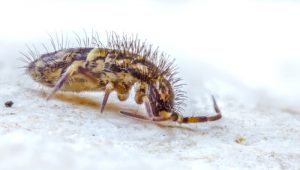Booklice and Springtails
By Chris Williams on June 28, 2011.
Booklice and Springtails are two completely different insects (with respect to their order and family) yet each have very similar lifestyles. Often times I’ll see them thriving in the same types of conditions within a customers home. First we’ll look at the booklice. The first couple of thoughts you might have could be; Are they lice? Will they bite? Although they are very similar looking to some types of lice, they do not bite and are considered to be harmless. These tiny (>1/16”) off-white colored insects feed on the mold that grows on objects (furniture, books, wallboard etc.) in excessively damp places. I often see them on windowsills. This past summer I treated a home for booklice where I observed them living on mildew that was growing on a sheetrock partition in the basement. To say the basement was damp would be quite an understatement, because you could practically squeegee the moisture off the walls. After I performed the service, I recommended to the customer that she clean up the mildew and take steps to lower the humidity level through ventilation and/or air conditioning. Booklice do not like it dry and of course, neither does the mildew.
 Springtails are also tiny insects (1/16”to 3/16”) and as a group maybe are a bit more diverse in their habits and habitat than the booklice. (For this discussion, I purposely left out any mention of barklice; the larger winged cousins of the booklice, because they do not invade dwellings) Springtails get their name due to a peculiar hinged appendage called a furcula. They are able to manipulate this device in a certain way to help propel themselves forward at up to four inches per jump! One dark colored species of springtail will gather in large numbers on old snow where they’ll feed upon molds, algae, etc. I’ve seen these ‘snow fleas’ when cross-country skiing during milder winter days in Feb. and Mar. Sometimes we’ll (Colonial Pest) get calls for ‘snow fleas’ invading people’s basements around windows, and bulkheads. These are not true fleas, and do not bite, but large numbers of them in a basement can be a nuisance. At other times of the year springtails may be seen in damp areas of the homes such as basements, crawlspaces, bathrooms, or around house plants. (They are living in the potting soil.) Controlling humidity is key in preventing these insects from building up in these areas. Just like the booklice, some springtails seem to like damp windowsills, and they’ll feed off the mildew and algae that grow there. So, how can you tell if the tiny off-white insects on the windowsill are booklice or springtails? Simple. If you see it jump, it’s a springtail!
Springtails are also tiny insects (1/16”to 3/16”) and as a group maybe are a bit more diverse in their habits and habitat than the booklice. (For this discussion, I purposely left out any mention of barklice; the larger winged cousins of the booklice, because they do not invade dwellings) Springtails get their name due to a peculiar hinged appendage called a furcula. They are able to manipulate this device in a certain way to help propel themselves forward at up to four inches per jump! One dark colored species of springtail will gather in large numbers on old snow where they’ll feed upon molds, algae, etc. I’ve seen these ‘snow fleas’ when cross-country skiing during milder winter days in Feb. and Mar. Sometimes we’ll (Colonial Pest) get calls for ‘snow fleas’ invading people’s basements around windows, and bulkheads. These are not true fleas, and do not bite, but large numbers of them in a basement can be a nuisance. At other times of the year springtails may be seen in damp areas of the homes such as basements, crawlspaces, bathrooms, or around house plants. (They are living in the potting soil.) Controlling humidity is key in preventing these insects from building up in these areas. Just like the booklice, some springtails seem to like damp windowsills, and they’ll feed off the mildew and algae that grow there. So, how can you tell if the tiny off-white insects on the windowsill are booklice or springtails? Simple. If you see it jump, it’s a springtail!